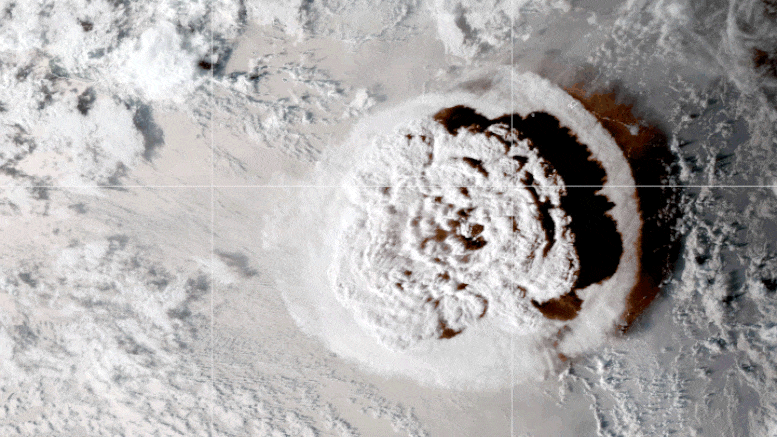
This looping video shows a series of GOES-17 satellite images that caught an umbrella cloud generated by the underwater eruption of the Hunga Tonga-Hunga Ha’apai volcano on January 15, 2022. Crescent-shaped bow shock waves and numerous lighting strikes are also visible. Credit: NASA Earth Observatory image by Joshua Stevens using GOES imagery courtesy of NOAA and NESDIS
Hunga Volcano Eruption Provides an Explosion of Data
The gigantic January 15, 2022, eruption of the Hunga submarine volcano in the South Pacific Ocean devastated the island nation of Tonga and created a variety of atmospheric wave types, including booms heard 6,200 miles (10,000 km) away in Alaska. It also created an atmospheric pulse that caused an unusual tsunami-like disturbance that arrived at Pacific shores sooner than the actual tsunami.
Those are among the many observations reported by a team of 76 scientists from 17 nations that researched the eruption’s atmospheric waves, the largest known from a volcano since the 1883 Krakatoa eruption. The team’s work, compiled in an unusually short amount of time due to significant scientific interest in the eruption, was published on May 12, 2022, in the journal Science.
David Fee, director of the Wilson Alaska Technical Center at the University of Alaska Fairbanks Geophysical Institute, is a leading author of the research paper and among four of the center’s scientists involved in the research.
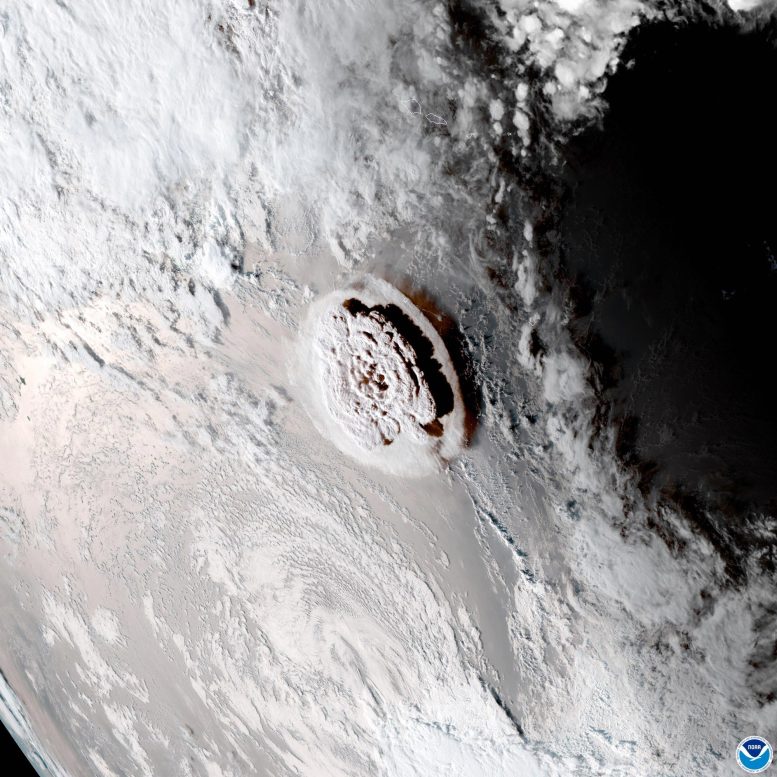
The Hunga eruption image is from the GOES-17 satellite of the National Oceanic and Atmospheric Administration. Credit: NOAA
The Hunga eruption, near the island of Tonga, has provided unprecedented insight into the behavior of some atmospheric waves. A dense network of barometers, infrasound sensors, and seismometers in Alaska — operated by the Geophysical Institute’s Wilson Alaska Technical Center, Alaska Volcano Observatory, and Alaska Earthquake Center — contributed to the data.
“Our hope is that we will be better able to monitor volcanic eruptions and tsunamis by understanding the atmospheric waves from this eruption,” said Fee, who is also the coordinating scientist at the Geophysical Institute’s portion of the Alaska Volcano Observatory.
“The atmospheric waves were recorded globally across a wide frequency band, and by studying this remarkable dataset we will better understand acoustic and atmospheric wave generation, propagation and recording,” he said. “This has implications for monitoring nuclear explosions, volcanoes, earthquakes and a variety of other phenomena.”
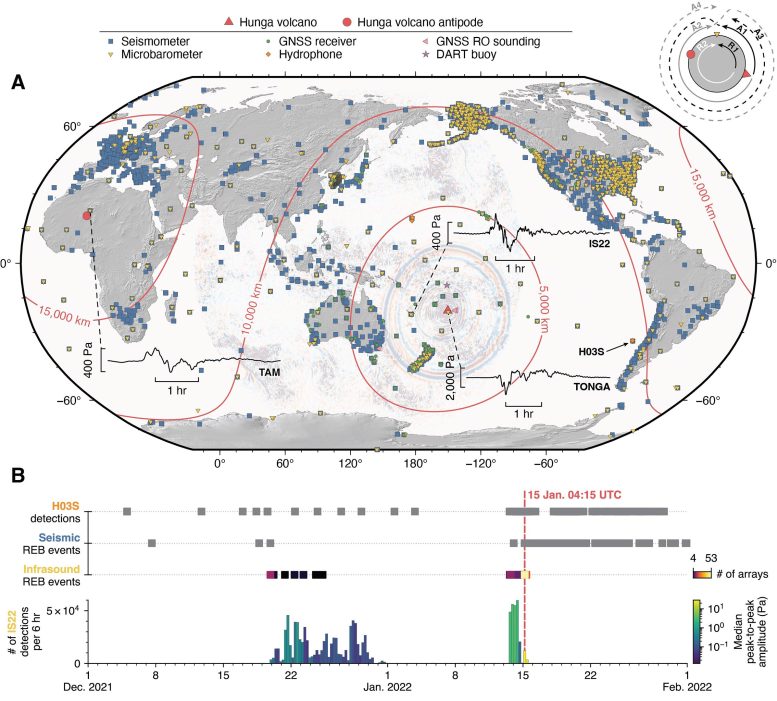
Top image shows locations of instruments that provided data. Red-and-blue pattern around Hunga volcano is a time snapshot image from a weather satellite showing the atmospheric disturbance created by the Lamb wave. Bottom image shows two months of Hunga activity. Credit: David Fee
The researchers found particularly interesting the behavior of the eruption’s Lamb wave, a type named for its 1917 discoverer, English mathematician Horace Lamb.
The largest atmospheric explosions, such as from volcanic eruptions and nuclear tests, create Lamb waves. They can last from minutes to several hours.
A Lamb wave is a type of guided wave that travels parallel to a material’s surface and also extends upward. With the Hunga eruption, the wave traveled along Earth’s surface and circled the planet in one direction four times and in the opposite direction three times — the same as observed in the 1883 Krakatau eruption.
“Lamb waves are rare. We have very few high-quality observations of them,” Fee said. “By understanding the Lamb wave, we can better understand the source and eruption. It is linked to the tsunami and volcanic plume generation and is also likely related to the higher-frequency infrasound and acoustic waves from the eruption.”
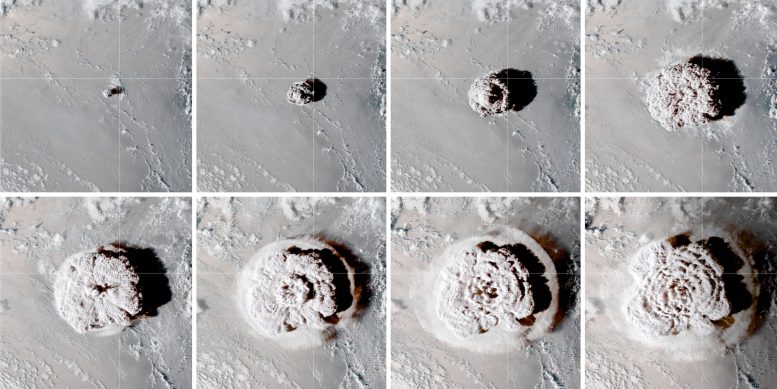
A NASA satellite captured the explosive eruption of Hunga Tonga–Hunga Ha‘apai in the South Pacific. Credit: Image by Joshua Stevens/NASA Earth Observatory, using GOES-17 imagery courtesy of National Oceanic and Atmospheric Administration and National Environmental Satellite, Data and Information Service
The Lamb wave consisted of at least two pulses near Hunga, with the first having a seven- to 10-minute pressure increase followed by a second and larger compression and subsequent long pressure decrease.
The wave also reached into Earth’s ionosphere, rising at 700 mph (300 meters/second) to an altitude of about 280 miles (450 kilometers), according to data from ground-based stations.
A major difference with the Hunga explosion’s Lamb wave compared to the 1883 wave is the amount of data gathered due to more than a century of advancement in technology and a proliferation of sensors around the globe, according to the paper.
Scientists noted other findings about atmospheric waves associated with the eruption, including “remarkable” long-range infrasound — sounds too low in frequency to be heard by humans. Infrasound arrived after the Lamb wave and was followed by audible sounds in some regions.
Audible sounds, the paper notes, traveled about 6,200 miles to Alaska, where they were heard around the state as repeated booms about nine hours after the eruption.
“I heard the sounds but at the time definitely did not think it was from a volcanic eruption in the South Pacific,” Fee said.
The Alaska reports are the farthest documented accounts of audible sound from its source. That is due in part, the paper notes, to global population increases and advances in societal connectivity.
“We will be studying these signals for years to learn how the atmospheric waves were generated and how they propagated so well across Earth,” Fee said.
Reference: “Atmospheric waves and global seismoacoustic observations of the January 2022 Hunga eruption, Tonga” by Robin S. Matoza, David Fee, Jelle D. Assink, Alexandra M. Iezzi, David N. Green, Keehoon Kim, Liam Toney, Thomas Lecocq, Siddharth Krishnamoorthy, Jean-Marie Lalande, Kiwamu Nishida, Kent L. Gee, Matthew M. Haney, Hugo D. Ortiz, Quentin Brissaud, Léo Martire, Lucie Rolland, Panagiotis Vergados, Alexandra Nippress, Junghyun Park, Shahar Shani-Kadmiel, Alex Witsil, Stephen Arrowsmith, Corentin Caudron, Shingo Watada, Anna B. Perttu, Benoit Taisne, Pierrick Mialle, Alexis Le Pichon, Julien Vergoz, Patrick Hupe, Philip S. Blom, Roger Waxler, Silvio De Angelis, Jonathan B. Snively, Adam T. Ringler, Robert E. Anthony, Arthur D. Jolly, Geoff Kilgour, Gil Averbuch, Maurizio Ripepe, Mie Ichihara, Alejandra Arciniega-Ceballos, Elvira Astafyeva, Lars Ceranna, Sandrine Cevuard, Il-Young Che, Rodrigo De Negri, Carl W. Ebeling, Läslo G. Evers, Luis E. Franco-Marin, Thomas B. Gabrielson, Katrin Hafner, R. Giles Harrison, Attila Komjathy, Giorgio Lacanna, John Lyons, Kenneth A. Macpherson, Emanuele Marchetti, Kathleen F. McKee, Robert J. Mellors, Gerardo Mendo-Pérez, T. Dylan Mikesell, Edhah Munaibari, Mayra Oyola-Merced, Iseul Park, Christoph Pilger, Cristina Ramos, Mario C. Ruiz, Roberto Sabatini, Hans F. Schwaiger, Dorianne Tailpied, Carrick Talmadge, Jérôme Vidot, Jeremy Webster and David C. Wilson, 12 May 2022, Science.
DOI: 10.1126/science.abo7063
Other Geophysical Institute scientists involved in the research include graduate student Liam Toney, acoustic wave analysis, figure and animation production; postdoctoral researcher Alex Witsil, acoustic wave analysis and equivalent explosive yield analysis; and seismo-acoustic researcher Kenneth A. Macpherson, sensor response and data quality. All are with the Wilson Alaska Technical Center.
The Alaska Volcano Observatory, National Science Foundation, and U.S. Defense Threat Reduction Agency funded the UAF portion of the research.
Robin S. Matoza of the University of California, Santa Barbara, is the paper’s lead author.


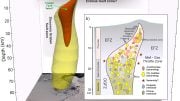




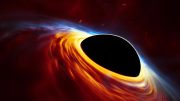
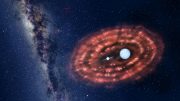
Interesting . Thoughts , which may be worth considering to manage catastrophic risks
1. At the outset let me state that Data Never Lies. It is the interpretation of Data which misleads.
2. This is a Energy – matter and Phases of Matter problem. Matter in a two dimensional world of Space-Time and and if we are living in a 3-D or 4-D World of Unknown dimension can be a solid, Liquid or Gas and Plasma. There could be other States of Matter, which most Scientists are unaware of as of today.
3. Why does a Volcano Erupt ” It is the Lava / Earths Magma Liquid Matter surrounding the Core of the Earth and Huge Pressure-Temperature built up, finding a release and coming/ bubbling up to the Earths Surface (Could be on continental Shelf, land based active/dormant volcanoes or Volcanoes under the Seas and Oceans.
4. In this case we are looking at the data from the Huge “Tonga” ‘Explosion’ deep underwater and its impact on Planet Earth. When Lava or the earths magma comes out, in a massive explosion and meets the Ocean Water we have a underwater Volcano , where matter at high temperature and pressure finds release. Remember Matter = Energy. So Emery in its Myriad forms like sound are released. Sound which can be heard and sound which are beyond the range of human hearing.
5. What we have here is a release of Particles constituting the Planet Earth into the Ocean, Atmosphere, stratosphere, Ionosphere….
6. The Release of such Particles- and its associated Energy into the Ocean is the release of a huge amount of Kinetic Energy into the Ocean. We observe the same as “Waves”. I suspect Waves are a pattern we observe of such Nano-Particles, but at the core of every wave we are actually observing nano-particles.
7.If such signals can be detected early in the Volcanic Cycle, we can develop Early-Warning Systems (EWS) AND take preventive action as far as the after-effects like Tsunami (when Lava or Magma Meets Oceans), Earthquakes ( When these huge Forces) meets Solid Earth/ Other solid or viscous matter).
8. When it meets the Atmosphere, etc. we observe various Natural Phenomenon like Lightning, Auroras etc.
9. Probably Geothermal source of Energy is one of the most abundant ones available which we have ignored for a very very long time like we have ignored power from Photovoltaic Phenomenon. These Technologies if developed and managed could be a boon for future generations. Even when the Sun becomes a RED Dwarf.
Views expressed are personal and not binding on anyone.